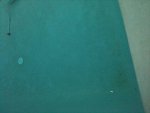I am still trying to get the hang of keeping all my levels in check, and just when I think I have a handle on it, a new issue has appeared. I have included pics in hopes that someone can identify my problem.
Specs:
25,000 gal, SWG, gunite pool (only a year and a half old)
pH 7.2-8.0 (fighting to keep it down since the beginning, but not as bad lately)
Free Chlorine 3-5ppm
TA 80-100ppm
CYA 30-50ppm
Salt 3200 ppm
Our plaster is white and I had noticed some greyish splotchy, swirly markings in the bottom, but not very dark or noticeable. Lately, it has become more pronounced and widespread. Some rust looking spots in places appeared overnight as well. We have had some black algae problems which we are still fighting somewhat, but hasn't been a big issue and mostly a problem in grout of the tile and in corners of the steps. My levels all seem to be good according to my test strips (and pool store didn't find anything out of balance either when I brought in a sample). Any advice is welcome. We are about to be out of town for a week and want to try and nip this before we leave. Thanks![attachment=1:1ng0y0bg]photo.JPG[/attachment:1ng0y0bg][attachment=0:1ng0y0bg]photo2.JPG[/attachment:1ng0y0bg]
Specs:
25,000 gal, SWG, gunite pool (only a year and a half old)
pH 7.2-8.0 (fighting to keep it down since the beginning, but not as bad lately)
Free Chlorine 3-5ppm
TA 80-100ppm
CYA 30-50ppm
Salt 3200 ppm
Our plaster is white and I had noticed some greyish splotchy, swirly markings in the bottom, but not very dark or noticeable. Lately, it has become more pronounced and widespread. Some rust looking spots in places appeared overnight as well. We have had some black algae problems which we are still fighting somewhat, but hasn't been a big issue and mostly a problem in grout of the tile and in corners of the steps. My levels all seem to be good according to my test strips (and pool store didn't find anything out of balance either when I brought in a sample). Any advice is welcome. We are about to be out of town for a week and want to try and nip this before we leave. Thanks![attachment=1:1ng0y0bg]photo.JPG[/attachment:1ng0y0bg][attachment=0:1ng0y0bg]photo2.JPG[/attachment:1ng0y0bg]



